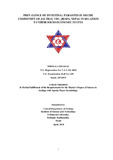Please use this identifier to cite or link to this item:
https://elibrary.tucl.edu.np/handle/123456789/1439| Title: | Prevalence of Intestinal Parasites in Meche Community of Jalthal VDC, Jhapa, Nepal in Relation To Their Socio-Economic Status |
| Authors: | Dhakal, Nirmala |
| Keywords: | INTESTINAL PARASITES IN MECHE;JALTHAL VDC, JHAPA |
| Issue Date: | Apr-2018 |
| Publisher: | Central Department of Zoology Institute of Science and Technology Tribhuvan University, Kirtipur, Kathmandu, |
| Abstract: | Intestinal parasitic infection possesses great morbidity among people with low socio-economic status as well as people living in poor hygiene and sanitary condition. This study was carried out to determine the prevalence of intestinal parasites in Meche community of Jalthal Village Development Committee of Jhapa district in relation to their socio-economic status during June to July 2017. A total of 150 stool sample were randomly collected from different age groups and sexes and were preserved in 2.5% potassium dichromate solution. The prevalence of the intestinal parasites was determined by stool examination using direct smear and concentration methods (sedimentation and flotation technique) in the Parasitology Laboratory of Central Department of Zoology, Kirtipur, Kathmandu whereas knowledge, attitude and practices (KAP) of the people were analyzed using prepared questionnaire. Out of 150 peoples, 41(27.33%) were found to be infected with one or two intestinal parasites among them prevalence rate in females were higher (32.47%) than males (21.91%). Statistically there was no significant difference in the sex-wise prevalence of the intestinal parasites (P>0.05). The prevalence of the parasites was higher in the age group 21-40 years (47.22%) and lowest (20.51%) in the elder people above 41 years of age. However the difference was not statistically significant (P>0.05). Altogether 5 species of the intestinal parasites were detected. Among them Ascaris lumbricoides (19.33%) topped the list followed by Taenia solium (2.67%), Hookworm (2.67%), Entamoeba coli (2.67%) and Trichuris trichiura (2%). The study revealed that the prevalence of single infection (92.68%) was higher than double infection (7.32%). Most of the people (70%) were unaware and (30%) people were aware about intestinal parasitic infection. Thus, the high prevalence of intestinal parasitic infection among Meche people seems directly related to unhygienic living condition, unsafe drinking water, unhygienic food, lack of health education, poor sanitary condition and low socio-economic status help to increase the burden of the infection in the community. |
| URI: | http://elibrary.tucl.edu.np/handle/123456789/1439 |
| Appears in Collections: | Zoology |
Files in This Item:
| File | Description | Size | Format | |
|---|---|---|---|---|
| Thesis final .pdf | 1.4 MB | Adobe PDF |  View/Open |
Items in DSpace are protected by copyright, with all rights reserved, unless otherwise indicated.
